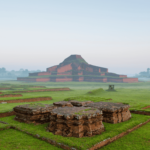Introduction:
Welcome to one of the most iconic landmarks in Bangladesh—the Shat Gambuj Mosque, a 15th-century architectural masterpiece. Nestled in the historic city of Bagerhat, this UNESCO World Heritage Site is not only a religious center but also a testament to the architectural brilliance of its time. Did you know the mosque boasts a total of 77 domes, despite its name meaning “Sixty Dome Mosque”? Let’s dive into its rich history, remarkable architecture, and cultural significance that makes this mosque a must-see destination for both history buffs and travelers alike!
History of the Shat Gambuj Mosque
The Shat Gambuj Mosque, or Sixty Dome Mosque, is a historical gem that dates back to the 15th century. Built by the revered Turkish general Khan Jahan Ali, it served as both a place of worship and a military outpost during the early days of Islamic expansion in Bengal.
-
- Foundation & Construction: The mosque was constructed between 1442 and 1459 under the supervision of Khan Jahan Ali, who was instrumental in spreading Islam in the Bengal region. It stands as one of the largest and most prominent mosques of the Sultanate period.
-
- Strategic Location: Situated in Bagerhat, near the coastal belt of southwestern Bangladesh, the location was crucial for defending the region from potential invaders. It also acted as a community centre for newly converted Muslims in the area.
-
- Inscriptions and Dedications: The mosque is adorned with several inscriptions that reflect the glory of Sultan Nasiruddin Mahmud Shah and Khan Jahan Ali, who dedicated his life to building a strong Islamic community.
Architectural Features
The Shat Gambuj Mosque is a marvel of Islamic architecture, blending local Bengali styles with Persian and Arabian influences. Despite its name, the mosque features 77 domes, with 60 stone pillars supporting the central structure, and a grand corrugated roof.
-
- Unique Dome Structure: The most striking feature of the mosque is its row of domes, arranged in 11 rows of 7 domes each. The central prayer hall is crowned by a large dome, which creates a majestic ambiance inside.
-
- Arches and Pillars: The mosque features a series of pointed arches that support the domes. These arches, along with stone pillars, give the mosque its sense of scale and grandeur. The use of multiple arches in the design was influenced by Sultanate architecture.
-
- Terracotta Ornamentation: The exterior and interior are richly adorned with terracotta tiles, which are engraved with floral motifs, geometric patterns, and Arabic calligraphy. This style of decoration is typical of Bengali mosques from this period.
Cultural and Religious Importance
For centuries, the Shat Gambuj Mosque has been a significant center of religious activity and community life in Bagerhat.
-
- Religious Practices: The mosque still functions as a place of worship, attracting hundreds of devotees during Friday prayers and Islamic festivals. During Eid and Ramadan, the mosque becomes a focal point for large gatherings.
-
- Cultural Influence: Beyond its religious importance, the mosque has played a key role in shaping the cultural identity of the region. Local artisans and craftsmen drew inspiration from the mosque’s design, influencing the region’s architectural traditions for centuries.
The Restoration and Preservation of the Mosque
The Shat Gambuj Mosque was declared a UNESCO World Heritage Site in 1985, recognizing its global cultural significance and the need for preservation.
-
- UNESCO’s Role: The global recognition helped spur efforts to restore the mosque. Several conservation projects were initiated to restore damaged sections and prevent further deterioration due to natural causes like erosion and moisture.
-
- Preservation Challenges: Restoring a structure as old and complex as this one comes with its challenges. Over the years, parts of the mosque’s foundation have weakened due to the region’s monsoon climate. However, international and local experts continue to work together to maintain its structural integrity.
Visiting the Shat Gambuj Mosque: A Traveller’s Guide
If you’re planning to visit Shat Gambuj Mosque, here’s what you need to know:
-
- Best Time to Visit: The winter months (October to March) offer the best weather for exploring Bagerhat. This time of year is perfect for outdoor activities and sightseeing.
-
- Getting There: Bagerhat is easily accessible from Khulna, which is well-connected by road from major cities like Dhaka and Chittagong. Local buses, taxis, and rickshaws are available to take you to the mosque.
-
- Nearby Attractions: Don’t miss other historical landmarks in Bagerhat, including Khan Jahan Ali’s Tomb and Nine Dome Mosque. You can also explore the Sundarbans, the world’s largest mangrove forest, just a short distance away.
-
- Travel Tips: Dress modestly when visiting the mosque, as it’s a religious site. Photography is allowed, but make sure to respect the worshippers and the sanctity of the space.
Conclusion
The Shat Gambuj Mosque is more than just an architectural wonder—it’s a symbol of Bangladesh’s rich Islamic heritage and a testament to the craftsmanship of a bygone era. Visiting this historic site is like stepping back in time to a period when Bengal was at the forefront of Sultanate architecture and cultural exchange. Whether you’re drawn by the mosque’s imposing beauty, its religious significance, or its cultural importance, it’s a place that will leave a lasting impression on anyone who visits. Don’t miss your chance to witness one of the finest examples of Islamic architecture in South Asia!
Ready to explore the treasures of Bagerhat and immerse yourself in Bangladesh’s glorious past? Start planning your trip to the Shat Gambuj Mosque today!







